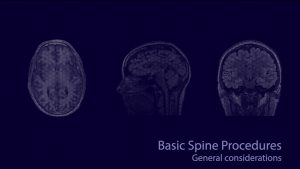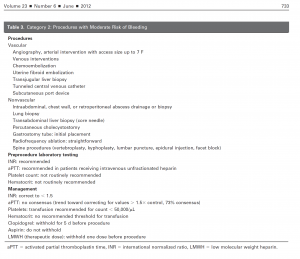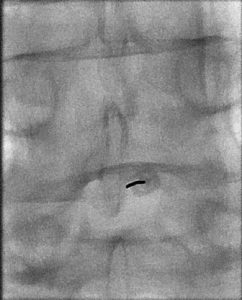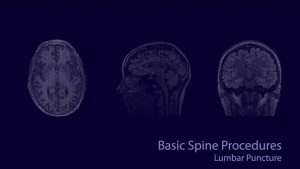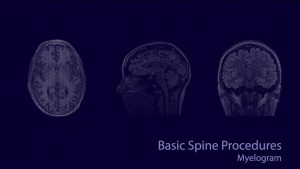Neuroradiology procedures
Procedures are a key part of neuroradiology. The most commonly performed procedures include: lumbar punctures, myelograms, cisternograms, biopsies, and blood patches. Every trainee should have a rudimentary knowledge of these procedures, including indications for performing them, how they are performed, and common risks and contraindications.
General considerations
Some of the considerations that should be considered before performing any procedure in neuroradiology. This includes allergies, anticoagulation, patient size, what type of imaging guidance should be used, and more. The video in the link talks more about what some of these considerations, which is further discussed on this page.
Procedure risks
The major risks of performing a neuroradiology procedure are bleeding, infection, and damage to adjacent structures.
Bleeding: the majority of spine procedures are categorized as moderate risk of bleeding. However, overall the risk of significant bleeding is quite small (< 1/1,000-10,000). However, a number of small vessels and epidural veins are present in the region in which these procedures are performed. So there is a real, but small risk of bleeding.
Infection: Infection is quite unlikely after lumbar puncture or other minor procedure. Wearing masks, caps, and thoroughly disinfecting the skin are precautions we take to minimize the risk of infections.
Damage to adjacent structures: Most procedures are done caudal to the spinal cord, so the risk of spinal cord injury is low. However, damage to nerve roots, blood vessels, or the disc are possible.
Before beginning any procedure, these risks, although small, should be discussed with the patient. Special precautions should be taken for any patient on anticoagulation, described further below
Anticoagulation
Coagulation abnormalities increase the risk of procedures. Coagulation abnormalities can be the results of another condition (such as elevated INR from hepatic failure or thrombocytopenia) or can be iatrogenic due to anticoagulation. These abnormalities need to be addressed prior to performing procedures.
In general, you should do the following:
- Correct INR to 1.5 or less
- Correct platelets to 50,000 or more
- Stop anticoagulants the appropriate amount of time before the procedure.
There are situations in which you might undertake additional risk because the high potential benefit of the procedure outweigh the risk. However, you would only want to do this in situations which justify it and with due consideration between the primary treatment team and the radiologist.
Check out the page on anticoagulation and spine procedures to learn more.
Common procedures
The two most common neuroradiology procedures are lumbar punctures and myelograms. Other procedures are variations on these procedures, including lumbar drains, intrathecal chemotherapy, and cisternograms.
Lumbar puncture – description
One of the most common procedures in neuroradiology is the lumbar puncture. There are a number of indications for lumbar puncture in both inpatients and outpatients. While many patients can have lumbar puncture without image guidance, there are a variety of reasons for performing the puncture with image guidance. These include factors which may make landmark guided lumbar puncture difficult, including large body habitus, history of prior spinal surgery, or advanced degenerative changes.
While lumbar puncture can be performed with guidance via fluoroscopy, CT, or MRI, by far the most common source of image guidance is fluoroscopy. This is due to its relatively low radiation dose, low cost, and ease of use. CT and MRI tend to be reserved for more advanced cases. Prior to spinal puncture, the patient’s prior imaging (radiographs, CT, or MRI) should be reviewed.
Lumbar puncture – video
This video specifically discusses how to perform a fluoroscopy guided lumbar puncture, including what needles to use, how to steer the needle, and how to best position the patient. Pressure measurement and fluid collection is also discussed.
Myelogram – video
This video specifically discusses how to perform a myelogram. This includes how to choose a contrast agent, how to attach your tubing and inject the contrast, and what kind of warning signs to look for when injecting.
More complex procedures
There is a range of more complex procedures that are performed in neuroradiology. This includes:
- Biopsy
- Blood patch
- Cisternogram
- Pain procedures
More detail about these procedures will be added to this page in the future.
Click here to see all the procedure related posts on the site.
Books/other resources
There are not a lot of books about neuroradiology procedures, and it may make more sense to check out the most recent Radiographics or Neurographics articles on lumbar punctures or myelograms. However, the following book is pretty useful.
Image-Guided Spine Intervention – Douglas Fenton and Leo Czervionke
There is one very good book that is somewhat difficult to find, as it is not in wide print and was published in 2002. However, it has nice coverage of some more advanced procedures (primarily pain procedures) as well as some basics, such as needle guidance techniques. If you can get a copy, it’s definitely worthwhile.

